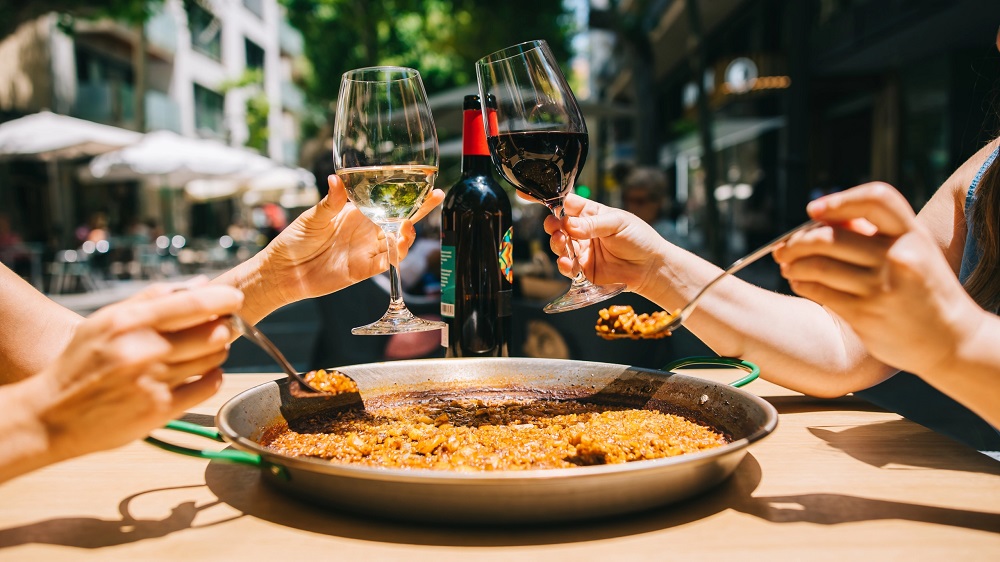Valencian food is a type of Mediterranean cuisine that is native to the Valencian Community, a region located on the east coast of Spain. This cuisine is characterized by its use of fresh and locally sourced ingredients, including seafood, rice, and fresh fruits and vegetables.
Valencia is also known for its wide variety of fresh seafood, and it is common to find a variety of dishes such as grilled fish, fried fish, or fish stews. These dishes are usually prepared with simple ingredients, such as olive oil, garlic, and lemon, and are designed to highlight the natural flavors of the fish.
Valencian cuisine also has a strong tradition of using fresh fruits and vegetables, which are often used in salads, soups, and stews. Popular vegetables in the region include tomatoes, artichokes, and green beans. One of the most traditional salads is called “ensalada valenciana” which is made with tomatoes, green beans, and oranges.
Also read: 10 Top Restaurants in Javea
Valencian famous food and dishes
One of the most famous dishes from Valencian cuisine is paella. This dish is a type of rice dish that is traditionally made with chicken, rabbit, and various types of vegetables. The dish is cooked in a large, shallow pan called a paellera and is seasoned with saffron, which gives the rice its distinctive yellow color. Modern variations of the dish can include seafood, such as clams, shrimp, and mussels, and sometimes even duck or snails.
Another popular dish from Valencian cuisine is Fideuà, which is similar to paella, but instead of using rice, it uses thin noodles. It is usually made with seafood and vegetables, and is often served with aioli or allioli, a traditional garlic and olive oil sauce.
Valencia is also known for its wide variety of fresh seafood, and it is common to find a variety of dishes such as grilled fish, fried fish, or fish stews. These dishes are usually prepared with simple ingredients, such as olive oil, garlic, and lemon, and are designed to highlight the natural flavors of the fish.
Valencia is also famous for its orange groves, and oranges are a staple in this region. They are used in many dishes and also in the famous traditional drink called “horchata” which is made from tiger nuts (a type of root vegetable) and orange blossom water.
Valencian cuisine has a strong influence from the Moorish culture that ruled the region for many centuries. This influence can be seen in the use of spices such as saffron, cumin, and paprika, which are commonly used in traditional dishes.
Best Valencian food with recipes for each dish
#1 Valencian Paella
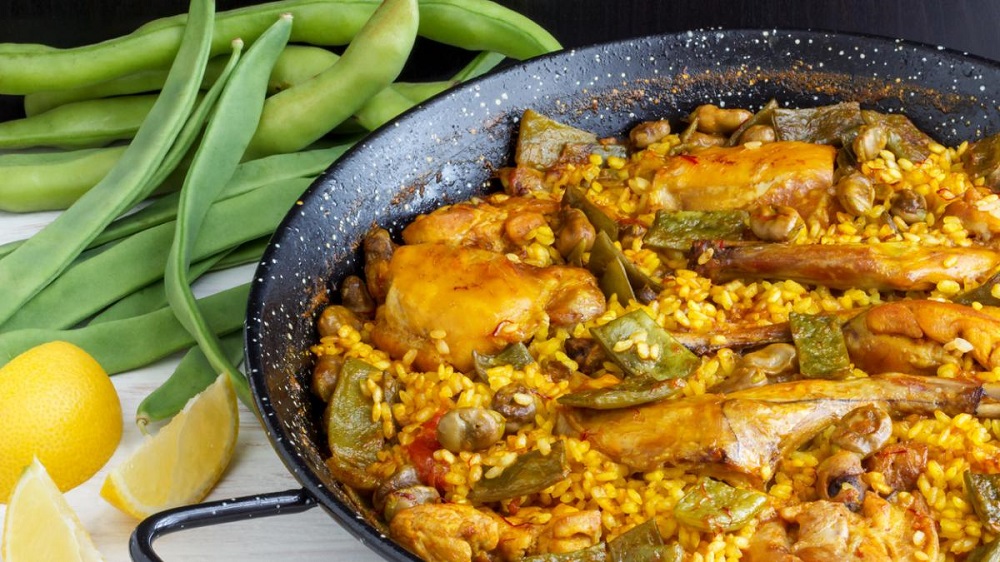
Paella is a traditional Spanish dish that originated in the Valencia region of Spain. It is typically made with rice, saffron, vegetables, and meat or seafood. The most traditional version of paella is Valenciana, which is made with rabbit, chicken, and beans. However, there are many variations of paella, including seafood paella, mixed paella, and even vegetarian paella.
The key to making a good paella is the rice. The rice used in paella is typically a short-grain rice, such as bomba or calasparra, which is capable of absorbing a lot of liquid and flavor. The rice is cooked in a large, shallow pan called a paellera, which is traditionally made of metal or enameled steel. The pan is heated over an open flame, and the ingredients are added in layers, starting with the meats and vegetables, followed by the rice and liquids. Read more about Valencian Paella and get the recipe to make a delicious meal for your friends and family.
#2 Arroz al horno

Arroz al horno, or baked rice, is a traditional Spanish dish that is typically found in the region of Valencia. It is a dish that is made with rice, vegetables, and meats, and it is often considered a variation of Paella. The dish is characterized by its unique preparation method, which involves cooking the rice, vegetables, and meats together in a casserole dish in the oven.
Arroz al horno is said to have originated in the coastal town of Albufera in Valencia, where it was traditionally made by fishermen using the catch of the day. The dish is typically made with a variety of meats such as chicken, rabbit, or pork, and vegetables such as bell peppers, onion, and tomatoes. Read more about Arroz al horno
#3 Bocadillo de carne de caballo

Bocadillo de carne de caballo, also known as horse meat sandwich, is a traditional Spanish dish that is typically found in the region of Valencia and Andalusia, particularly in the cities of Seville and Cordoba. The dish consists of a sandwich made with sliced horse meat, tomato, and onion, and is typically served on a crusty roll.
The history of Bocadillo de carne de caballo dates back to the 19th century, when horse meat was a common ingredient in the Spanish cuisine, particularly in the southern regions of the country. It was considered a cheap and readily available alternative to other meats such as beef and pork. The dish became particularly popular among working-class people and the sandwich was a convenient and easy to eat on the go. Read more about how to make a Bocadillo de carne de caballo
#4 Sobrassada – traditional Spanish sausage
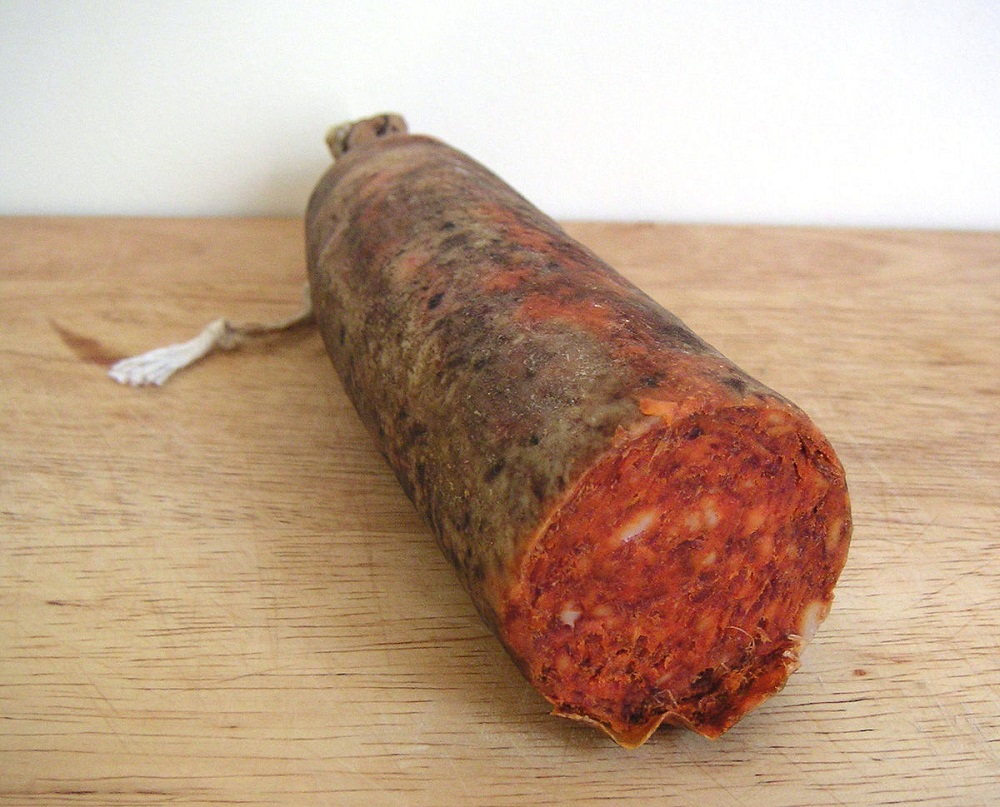
Sobrassada is a traditional Spanish sausage that is typically made from pork and originates from the island of Mallorca, located in the Balearic Islands. It is a type of cured sausage that is made by grinding pork meat and pork fat together, and then adding spices and paprika. The mixture is then stuffed into a natural pork casing and left to cure for a period of time.
The history of Sobrassada dates back to the 14th century, when the island of Mallorca was ruled by the Moors. They brought with them the technique of curing meats, which was then adopted by the local farmers. The sausage was traditionally made by farmers during the winter months, using the pork that was left over from the pig slaughter. Read more about the traditional Spanish sausage Sobrassada
#5 Bullit de Peix
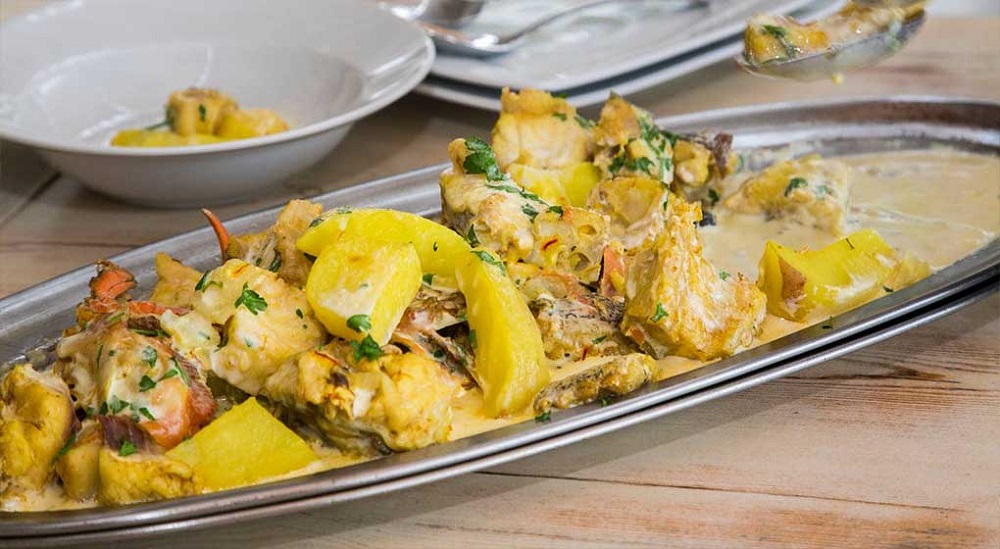
Bullit is a traditional Spanish dish that originates from the island of Menorca, located in the Mediterranean Sea. It is a hearty stew that is typically made with fish and potatoes, and is a staple dish on the island.
The dish is prepared by simmering fish, usually a white fish such as cod or hake, along with potatoes, onion, and tomatoes in a clay pot. The stew is seasoned with a variety of herbs and spices, such as bay leaves, thyme, and paprika. It is then cooked over low heat for several hours until the fish and potatoes are tender.
Bullit is typically served with a side of crusty bread, and is often accompanied by a glass of white wine or a cold beer. It is a comforting and satisfying dish that is perfect for a cold winter evening or as a main dish for a family dinner. Read more about how to make the traditional Spanish dish Bullit
#6 Clóchinas

Clochinas, also known as clam in Spanish, is a popular Spanish dish that is typically served as a tapa (small plate) or a main dish. It is made with clams, a type of bivalve mollusk that are commonly found in the Mediterranean Sea. Clochinas are a staple in the coastal regions of Spain, particularly in the Basque Country, Galicia and Valencia.
The dish is prepared by sautéing garlic, onion, and tomatoes in olive oil. Then the clams are added and they are cooked until they open. White wine, paprika and parsley are then added to the pan and cooked until the sauce reduces and thickens. The clochinas are then served with crusty bread to soak up the flavorful sauce.
Clochinas are a delicious and healthy dish, as they are low in calories and high in protein, vitamins and minerals. They are also a good source of omega-3 fatty acids, which are essential for a healthy heart. Read more about how to make Clóchinas
#7 Bunyols

Bunyols, also known as bunuelos, are a traditional Spanish dish that are typically served during the holiday season, particularly around All Saints’ Day and All Souls’ Day. These sweet fried dough balls are a beloved treat in Spain and can be found in many bakeries and cafes throughout the country.
The origins of bunyols can be traced back to the Moors, who introduced the concept of fried dough to Spain during their rule in the 8th century. Over time, the dish evolved and became a staple in Spanish cuisine. Bunyols can be made with a variety of ingredients, but the most common recipe includes flour, water, yeast, and sugar. The dough is then formed into small balls and deep-fried until golden brown.
One of the most popular variations of bunyols is called “bunyols de vent,” which translates to “wind doughnuts.” These bunyols are made with a lighter dough and are typically larger in size. They are also often shaped into a spiral and dusted with powdered sugar before serving. Read more about how to make Bunyols
#8 All i pebre

All i pebre is a traditional dish from the Catalonia region of Spain, known for its bold and flavorful combination of ingredients. At its core, the dish is a simple one, consisting of eel and a spicy sauce made with garlic, olive oil, and red pepper flakes. However, despite its simplicity, all i pebre has become a beloved and iconic dish in Catalonia, with many variations and interpretations found throughout the region.
The eel used in all i pebre is typically cooked in a variety of ways, such as grilled, fried or even boiled. The eel is then cut into small pieces and set aside. The sauce, or “pebre,” is made by sautéing garlic and red pepper flakes in olive oil until fragrant. The eel is then added to the sauce and cooked together for a few minutes, allowing the flavors to meld together. The dish is typically served with bread, which is used to soak up the delicious sauce.
One of the unique aspects of all i pebre is the use of red pepper flakes, which gives the dish its characteristic spice. The pepper flakes are typically sourced from the region of La Rioja, which is known for its high-quality and flavorful pepper varieties. The use of red pepper flakes is a nod to the traditional Catalan cuisine, which is known for its bold and spicy flavors. Check out the recipe to learn how to make All i pebre
#9 Coca de llanda

Coca de Llanda, also known as Coca de Recapte, is a traditional Spanish dish hailing from the Catalonia region. It is a type of flatbread that is typically served as an appetizer or snack, and can be topped with a variety of ingredients such as vegetables, meats, or cheeses.
The origins of Coca de Llanda can be traced back to medieval times, when it was a staple food of the farmers and peasants in the region. The dish was traditionally made with locally sourced ingredients, such as flour, oil, and salt, and was a way to stretch out a small amount of ingredients to feed a large number of people.
The dough for Coca de Llanda is made from flour, yeast, salt, and water. It is then rolled out into a thin, round shape and topped with the desired ingredients. Some popular toppings include tomato, onion, garlic, and olive oil, as well as more substantial options like meat and cheese. The pizza-like flatbread is then baked in a wood-fired oven, giving it a crispy crust and a soft and chewy center. Read more about how to make Coca de Llanda here
#10 Olla Valenciana

Olla Valenciana is a traditional Spanish dish from the Valencia region. It is a hearty and flavorful stew that is made with a variety of ingredients such as meats, vegetables, and pulses. It is a dish that is typically served as a main course and is often considered a variation of the famous Spanish paella.
The origins of Olla Valenciana can be traced back to the medieval period, when it was a common dish among the working-class population. The dish was originally made with simple ingredients such as meats, vegetables, and pulses, which were readily available and affordable. Over time, the dish has evolved and evolved to include a variety of meats, vegetables, and pulses, depending on the region and seasonality of the ingredients. Read more about Olla Valenciana here
#11 Coca de tomate

Coca de tomate is a traditional Spanish dish that is typically found in the Catalonia region. It is a type of pizza or flatbread that is made with a tomato and olive oil base, and it can be topped with various ingredients such as vegetables, meats, or seafood. The dish is typically served as a tapa or appetizer and it’s enjoyed throughout the year.
The origins of coca de tomate can be traced back to the medieval period, when it was a common dish among the working-class population. The dish was originally made with simple ingredients such as flour, water, and tomato, which were readily available and affordable. Over time, the dish has evolved and evolved to include a variety of toppings, depending on the region and seasonality of the ingredients. Read more about how to make Coca de tomate
#12 Arròs A Banda
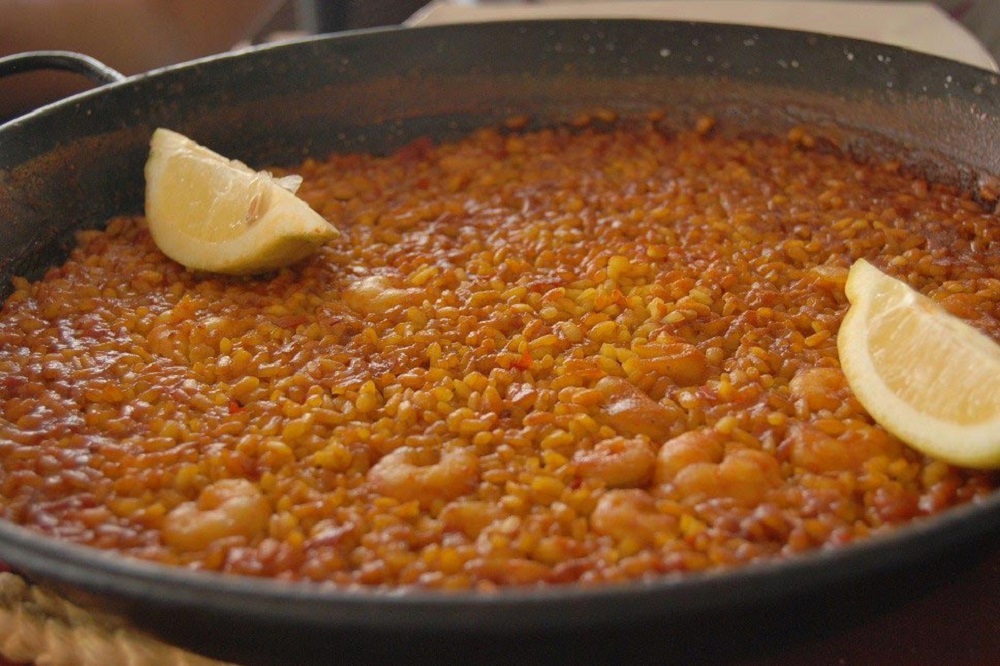
Arròs a banda is a traditional Spanish dish that is typically found in the region of Valencia. It is a dish that is made with rice, fish, and vegetables, and it is often considered a variation of Paella. The dish is characterized by its unique preparation method, which involves cooking the rice separately from the fish and vegetables, and then combining them together before serving.
Arròs a banda is said to have originated in the coastal town of Albufera in Valencia, where it was traditionally made by fishermen using the catch of the day. The dish is typically made with a type of fish called “llobarro” which is a red mullet, but other types of fish such as sea bass or bream can also be used.
The dish is made by first cooking the rice in a large pot with water and saffron. Then the fish is cooked in a separate pan with olive oil, garlic, and onions. The vegetables such as bell peppers and tomatoes are also cooked separately. After the rice, fish and vegetables are cooked, they are combined together in a large pot and simmered for a few minutes until the flavors are well combined. Read more about Arròs a Banda here
#13 Fideua
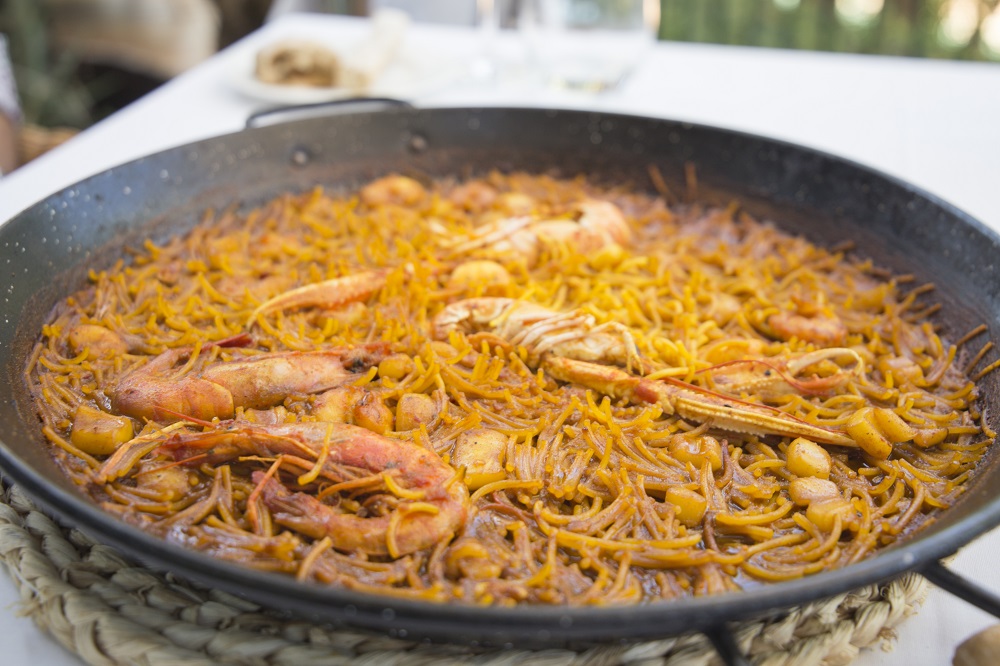
Fideua is a traditional Spanish dish that is typically found in the region of Valencia. It is a dish that is similar to Paella, but it is made with short, thin noodles called Fideos instead of rice. It is a flavorful and hearty dish that is often served as a main course.
The origins of Fideua can be traced back to the early 20th century, when it was first created by a group of fishermen in the region of Valencia. They created the dish as a way to use up their leftover noodles, and it quickly became a popular dish among the local community.
Fideua is made by sautéing short, thin noodles called Fideos in olive oil until they are slightly browned. Seafood, such as shrimp, squid, and mussels, is then added to the pan along with vegetables such as bell peppers, onion, and tomato. A broth made with fish stock, saffron, and paprika is then poured over the noodles, and the dish is cooked until the noodles are tender and the broth has been absorbed. Read more about how to make famous Spanish dish Fideua
#14 Esgarret

Esgarraet is a traditional Spanish dish that is typically found in the region of Valencia. It is a dish that is made with red peppers, cod, and olive oil. It is a flavorful and hearty dish that is often served as a tapa or a side dish.
Esgarraet is a dish that has its origins in the medieval period when Valencia was an important port city in the Mediterranean. The dish is said to have been created by the fishermen of the city as a way to preserve cod by using red peppers and olive oil. The dish was originally made with salted cod, but today it is typically made with fresh cod.
Esgarraet is made by sautéing sliced red peppers in olive oil until they are soft and tender. The cod is then added to the pan and cooked until it is flaky and fully cooked. The dish is typically seasoned with salt and pepper, and sometimes with other spices such as garlic or paprika. Read more about how to make the traditional Spanish dish Esgarraet
#15 Buñuelos de Calabaza

Buñuelos de Calabaza, also known as pumpkin fritters, are a traditional Spanish dish that are made with pumpkin, flour, and spices. They are a sweet and delicious treat that is often enjoyed during the fall and winter months, when pumpkin is in season.
The origins of Buñuelos de Calabaza can be traced back to medieval Spain, where they were a popular treat among the upper class. The dish is said to have been introduced to Spain by the Moors, who brought it with them from North Africa. The dish was originally made with sweetened milk, eggs, and honey, but over time, it evolved to include pumpkin as a key ingredient.
Buñuelos de Calabaza are made by combining pumpkin puree, flour, sugar, eggs, and spices such as cinnamon and nutmeg. The mixture is then formed into small balls and deep-fried until golden brown and crispy. They are often dusted with powdered sugar before serving and sometimes drizzled with honey or caramel sauce. Read more to find out how to make Buñuelos de Calabaza
#16 Flan de Calabaza

Flan de Calabaza, also known as pumpkin flan, is a traditional Spanish dessert that is made with pumpkin and eggs. It is a creamy and rich dessert that is perfect for a special occasion or a holiday meal.
The origins of Flan de Calabaza can be traced back to medieval Spain, where it was a popular dessert among the upper class. The dish is said to have been introduced to Spain by the Moors, who brought it with them from North Africa. The dish was originally made with sweetened milk, eggs, and honey, but over time, it evolved to include pumpkin as a key ingredient.
Flan de Calabaza is made with a combination of pumpkin puree, sugar, eggs, and milk. The pumpkin puree is cooked with sugar and spices such as cinnamon, nutmeg, and vanilla, until it is thick and creamy. The eggs and milk are then added to the mixture and it is cooked until it becomes a custard. The flan is then chilled and served cold, often with a caramel sauce drizzled on top. Read more to about how to make this delicious dessert Flan de Calabaza
#17 Turrón

Turrón is a traditional Spanish sweet treat that is typically consumed during the holiday season, particularly around Christmas. It is a type of nougat that is made with almonds and honey, and it has a rich, sweet, and nutty flavor.
Turrón originated in the region of Valencia, where it was first made by the Moors in the Middle Ages. The Moors brought the recipe with them when they invaded Spain, and it quickly became a popular treat among the local population.
There are two main types of Turrón: soft and hard. Soft Turrón, also known as Jijona Turrón, is made with almonds, sugar, and honey. It has a smooth and creamy texture, and it is typically shaped into bars or balls. Hard Turrón, also known as Alicante Turrón, is made with almonds, sugar, and egg whites. It has a harder, crunchier texture and it is typically shaped into bars or blocks. Read more about how to make traditional Spanish sweet Turrón
#18 Horchata and Fartons
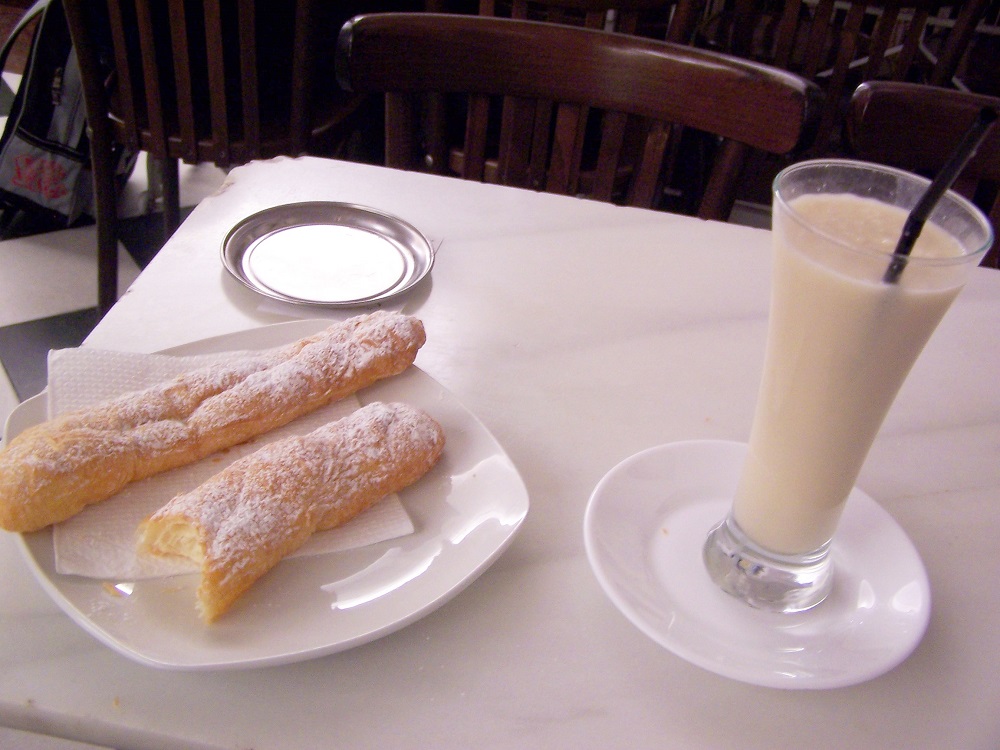
Horchata and Fartons are two traditional Spanish dishes that are commonly enjoyed together. Horchata is a sweet, creamy drink made from ground almonds, tiger nuts, or rice, while fartons are a type of sweet pastry.
Horchata is a refreshing and delicious drink that has been enjoyed in Spain for centuries. It is typically made by grinding nuts or rice and then mixing the resulting powder with water and sweeteners such as sugar or cinnamon. The resulting drink is creamy and sweet, and it is often served over ice. Horchata is a popular drink in Valencia, where it is made with tiger nuts and is known as “orxata.”
Fartons, on the other hand, are a type of sweet pastry that is typically made with flour, yeast, and sugar. They are shaped like long, thin strips and are often served warm. Fartons are most commonly enjoyed dipped in horchata, which is why they are often served together. The combination of the sweet and slightly crunchy pastry with the creamy and cool horchata is a classic Spanish treat. Read more about Horchata and Fartons
In conclusion, Valencian cuisine is a type of Mediterranean cuisine that is native to the Valencian Community, located on the east coast of Spain. It is characterized by its use of fresh and locally sourced ingredients, including seafood, rice, and fresh fruits and vegetables. Enjoy!
